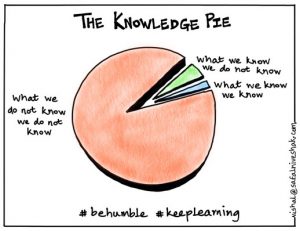When it comes to content ideas, you’re probably in one of two camps.
Either you have too many ideas on what to create or write about, or you’re feeling dry as a bone when it comes to creativity and inspiration.
We've reviewed the difference between search content strategy and social media content strategy in the previous post. So how should you go about creating this content? And which topic should you prioritize first?
If you’re wanting to know
- The quickest and easiest way to determine what to write about,
- How to determine what topics are popular in your industry, and
- How to ensure your content has the best chance for visibility in search results?
Long-Form Content Ideas: Figure Out What Content To Create - Post Outline
This article will give you a how-to you can start using now.
And to help with your pillar content process, I’ve created a “pillar content toolkit” of 5 FREE resources to help speed the process along, including a PDF copy of this entire guide. Cement what you learn and grab the toolkit here.
We'll follow a 4-step process to zero in on what content to write next.

Step 1: For More Content Ideas, Do A Brain Dump
As a seasoned expert, your head is full of anecdotes, areas of expertise, and other nuggets of wisdom that we want to capture and share with others.
A brain dump can help to get things out of your head, and there are a few ways to get the ideas flowing.
Brain dump idea #1: Freewriting
When you challenge yourself to write without any filter, you’ll notice you have to take some action and start writing from a stream of consciousness in order to keep your fingers moving along the way.
I personally use the resource 750words for both idea generation and my actual writing. If you just need a structure to keep you accountable, the site gives you a blank page to some unstructured writing.
Often, ideas will begin to surface when you are writing steadily.

If you want something a little more sadistic, Squibler acquired this “dangerous writing app”, which deletes all your progress on a prompt if you stop typing for more than five seconds. Yikes! Keep those content ideas flowing.

Brain dump idea #2: “Mindstorming”
Another approach is to stretch your creative problem-solving skills by coming up with many solutions to a single problem. Personal development guru Brian Tracy calls this approach “mindstorming”.
In mindstorming, you choose a problem, then come up with 20 solutions to that problem. As Mr. Tracy points out, the first ten flow fairly easily, the next five are hard, and the final five are downright excruciating.
Like the last reps in a set of lifting weights, these last solutions yield the biggest gains and will stimulate the creative centers of your brain to become stronger and more facile.
Brain dump idea #3: Keep track of fleeting ideas on the go
Consider creating a note in your Notes app and carrying around a small paper journal where you quickly jot down great ideas as they come to you throughout the day.
Lightning strikes at seemingly random times. You don’t want to miss out on a great idea or a great way to frame your ideas because your eureka moment happened in the coffee shop line right before it was time to order.
I use Notes personally, and I also have a tab in my writing tracker spreadsheet (part of the pillar content toolkit) where I house past ideas and snippets.
For More Content Ideas, Ask Your Audience
You’ve produced a truckload of ideas. However, these were all from your own brain.
There is a whole world of ideas that we “don’t know we don’t know”.

We can’t even ponder these ideas; if we could then they would move into the “what we know we don’t know” slice. There truly is an infinite amount of new information and new ideas to extract from the world.
To do this, start talking to people, and if you can, talk to those who would potentially consume your services.
You could also interview current or past clients on what they most need help with and what their burning pains are.
This is a great copywriting trick, because the language your ideal buyer or consumers to describe their pain and what takes the pain away can become the exact language you use in your marketing efforts.
Some questions you can ask your prospects, current clients, or people in your industry include:
- "What about your business keeps you up at night?"
- "If there is one thing you could solve about your business right now, what would it be?"
- "Describe the goals you have for this year and how to get there."
Then create content that addresses those desires, and you’ll have a piece of marketing that generates trust for your business or brand on autopilot.
Step 2: Define Your Content Objective
This is a guide on pillar content – long-form content that is usually housed on a website – but it’s good to identify your goals and objectives for any content you have in your marketing efforts.
With pillar content, and most forms of content, you have one of two objectives: communicate your methodology, or position yourself to be discovered by new people.
(Spoiler alert: the best-case scenario is to incorporate both approaches.)
Approach #1: The methodology approach
In the methodology approach, your show prospects and leads who are already aware of you that you have a unique and fresh approach to getting the job done.
Methodology content is not concerned with being discoverable in search engines; its primary purpose is to impress people who have already learned about you from some other source.
If methodology content has done its job, you don’t have to spend as much time or effort convincing people your offer is valuable when it’s time to sell; your content will have already educated people on the benefits of what you do and how much time they will save if they choose to pay for a solution.
Approach #2: The discovery approach
In the discovery approach, the priority is being discovered by new people. The majority of pillar content utilizes the discovery approach.
It’s important to note that in the discovery approach, you subordinate what you want to write about to the data you find about your topic.
Whatever people are searching for — the keywords they’re using, the questions they’re asking — takes priority over what you want to write about.
There’s nothing worse than spending weeks or months writing your magnum opus, only to have it collect dust and never be discovered because it isn’t aligned with what people search for each day.
For entrepreneurs, taking the discovery approach is a relief because you don’t have to be creative. You simply research what people are looking for, then create a great piece of content that answers those questions.
—
Most pillar content actually takes both of these approaches simultaneously.
But it is possible to create content that is not optimized for search (methodology approach) and still have success if the nature of your business is that new traffic comes from elsewhere.
Step 3: Research Relevant Keywords For Your Content Ideas
If you’re creating content that you want to be discoverable in a search engine like Google or YouTube, keyword research is an essential step.
Imagine you have a lemonade stand and you want to sell lemonade.

You need to be adjacent to a street or sidewalk in order to have any hope of making sales; if the lemonade stand is sequestered in your backyard, there’s only so many times dad can give you a pity sale.
You need traffic. But you also don’t want to set up next to a highway where there is way too much traffic, unless you have an operation that can compete.
Once you’ve become a drive-through selling lemonade and a hundred other items, then you can compete on high-traffic channels.
A good start is to find keywords that have 100-2,000 searches a month. This gives you the best chance of appearing in search results and not getting drowned out.
Keywords can be a single word or a phrase — here are a few types:
- Short-tail keywords are keywords that are just a word or two long, and are often very competitive.
- Long-tail keywords are long phrases that are very specific and niche, but less competitive. They have lower search volume, but dominating many different long-tail keywords can lead to a profitable business.
- Medium-tail keywords are in between short and long and have qualities of both. Most pillar content for small business owners and entrepreneurs does well with a medium-tail keyword focus.
You also want to research the number of results a search term has. The lower the number of results, the better, because there will be less competition.
Think about it: If you pursue a hypercompetitive keyword like “social media” or “keto diet” that has massive search volume and millions of results, it’ll become a challenge.
You’ll get drowned out by a massively competitive crowd of competition, many of whom are pushing tons of advertising dollars to dominate the keyword.
Most people skip this keyword research step because it feels granular. If you don’t align your content topic to what people are searching for, however, your masterpiece will disappear beneath the surface.
To see monthly keyword research volume, you can use a plugin like keywords everywhere or a tool like Google keyword planner.

Look for keywords that have between 100-2,000 searches a month. This is a good starting point, and you’re more likely to place on the first page of search results (or even become the #1 result) when the level of competition is low.
Step 4: Research Competition
Lastly, it’s good to see what other types of content have already been created on the internet that seek to solve the same problems you hope to solve.
In your keyword research, take a few moments to actually search the keyword and check out the top ranking content.
As you do this, ask yourself: “How could I create something that is better or different than what is being said here?”
In some cases, you’ll find that the content currently out there isn’t very good or suggests solutions that are just plain wrong.
Other times, you may have some outstanding content that has been produced by big companies with big budgets; in this case, you may want to create something similar, but for a slightly different audience
For example, Nerd Fitness has a dominant piece on meal-prepping.
So perhaps you can create a piece that is about meal-prepping for families of four or more - this more niche variation on the topic allows you to distinguish yourself.
--
So now you have a boatload of ideas and a proper way to vet them.
And you’re savvy to the idea that pillar content can support your brand or business no matter your current marketing strategy.
Let’s move on to my favorite step: how to produce a piece of pillar content that will wow your audience and make readers trust you and want to buy from you.
Thanks for reading. 🙏🏼
Keep up the momentum with one or more of these next steps:
📣 Share this post with your network or a friend. Sharing helps spread the word, and posts are formatted to be both easy to read and easy to curate – you'll look savvy and informed.
📲 Hang out with me on another platform. I'm active on Medium, Instagram, and LinkedIn – if you're on any of those, say hello.
📬 Sign up for my free email list. This is where my best, most exclusive and most valuable content gets published. Use any of the signup boxes in this article, or go to the newsletter page here.
🏕 Up your marketing game: Camp Wordsmith™ is my business and writing program for small business owners and online entrepreneurs. Get instant access to resources and templates guaranteed to make your marketing hustle faster, better, easier, and more fun. (It's also "glamping"-themed – who doesn't love luxurious camping?!) Learn more here.
📊 Hire my marketing company: Hefty Media Group provides consultation and done-for-you services in content marketing. We're a certified diversity supplier with the National Gay & Lesbian Chamber of Commerce, and we'll make you sound damn good via the written word. Learn more here.
© 2021, 2022, Hefty Media Group. All Rights Reserved.


